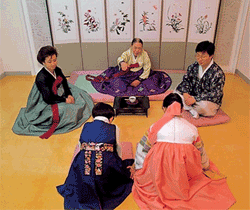The New Year's Day in Korea
[ 2007-01-11 17:25 ]
|
这篇文章选自《韩国风情录》这本书。文章介绍了韩国的传统节日——新年,以及韩国人民在新年里的一些风俗习惯。和中国一样,韩国实际上也过两个新年,而新年是韩国最盛大的两个传统节日之一。虽然每年的阳历1月1日和2日是法定的节假日,但大多数韩国家庭返乡团聚都是在阴历新年,即每年的1月末或2月初。和阳历新年一样,阴历新年也是辞旧迎新的日子。 |
|
 Solnal (New Year's Day)--First Day of the First Month Solnal (New Year's Day)--First Day of the First Month
This is
one of the two biggest holidays in Korea.
Like China, Korea actually
celebrates the New Year twice. While January 1st and 2nd are official holidays,
most families make the cross-country voyage to their hometowns for the Lunar New
Year, which falls in late January or early February. As in the West, this day
sends off the past year and ushers in the new. Perhaps nobody appreciates the
promise of a new start more than a Korean farmer.
For children, the most
popular custom is dressing up in rainbow-colored silk hanbok and performing the
sebae(New Year Bow) before all the elders of the family and wishing them
pok(fortune) for the coming year. In turn, they are rewarded with golden words
of advice and pocket money, the amount depending on their age and position in
the family. This is one custom that is in no danger of dying out from rapid
industrialization and urbanization, although its focus has shifted from paying
calls of respect on elders to paying young children to be good.
Some of
the other games that make this day special, but are losing ground to electronic
forms of recreation, are a tug-of-war, kite-flying, see-sawing, and yut-nori, a
kind of board game played with sticks.
Traditionally for girls over
seven, the see-saw was their window to the world. New Year's Day used to be
the only time of the year that girls could see over the courtyard walls.
Nowadays, the see-saw is more a test of rhythm and balance than the social event
girls looked forward to all year.
Jumping up and down on
the low, flat board is devilishly more difficult than it appears. There is no
fulcrum, so the momentum comes entirely from the timing of you and your
partner's leaps.
(This
article is excerpted from "Korean Scenes")
(通讯员上海第二工业大学外国语学院钱婧投稿 英语点津陈蓓编辑 ) |